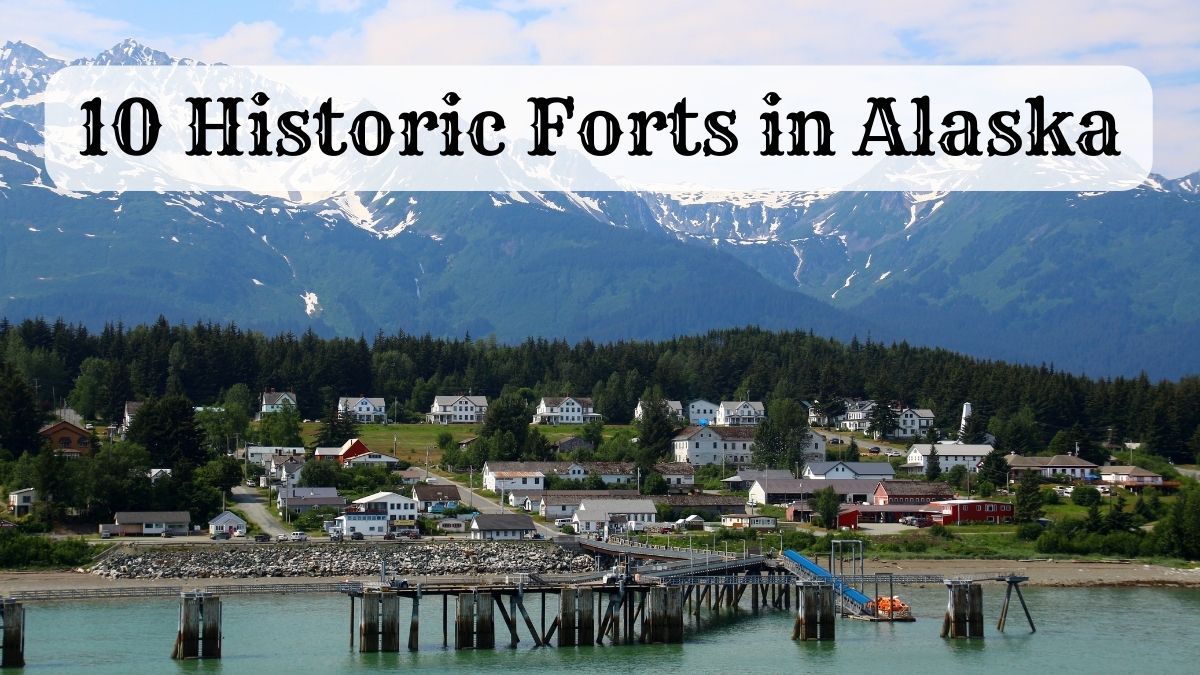With its rich history, Alaska has numerous historic forts that played pivotal roles in various historical events.
These forts, many of which are now recognized as National Historic Landmarks, offer a unique opportunity to explore the diverse military history of the United States on American soil.
This article on historic forts in Alaska delves into some of Alaska’s most significant historic forts, highlighting their roles during different periods, from the Klondike Gold Rush to World War II.
| 1. Fort Abercrombie | 6. Fort Davis |
| 2. Fort William H. Seward | 7. Fort Egbert |
| 3. Sitka National Historical Park (Old Sitka Fort) | 8. Fort Richardson |
| 4. Fort Yukon | 9. Fort McGilvray |
| 5. Fort Liscum | 10. Fort Greely |
1. Fort Abercrombie
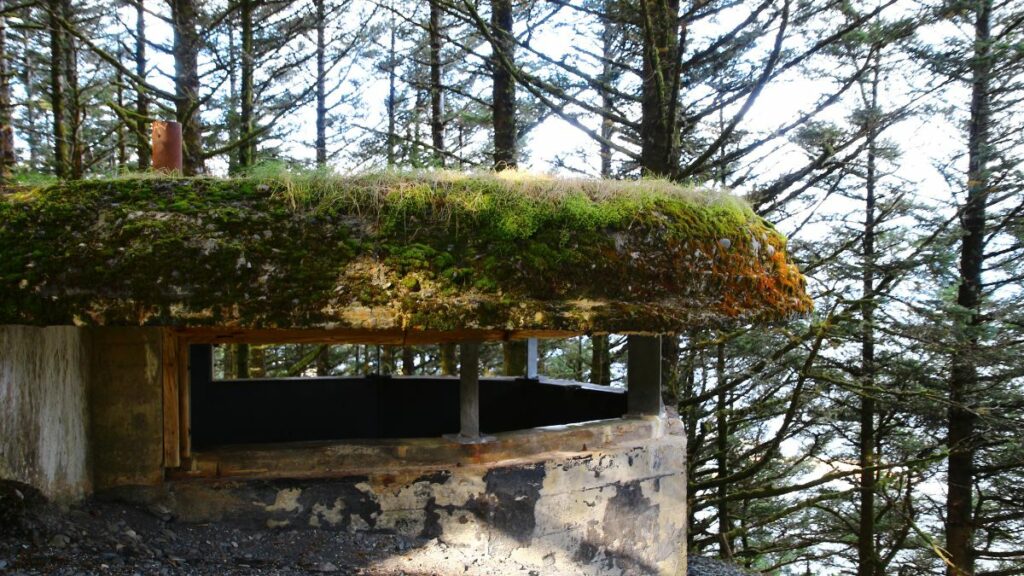
Fort Abercrombie, located on Kodiak Island, Alaska, stands as a historical testament to the strategic military efforts of the United States during World War II.
This base, often called the “Fortress of the North,” played a pivotal role in the defense strategies against potential invasions, particularly concerning the Soviet Union.
Fort Abercrombie was established in response to the growing tensions of World War II.
Officially commissioned in 1941, the fort was part of a broader strategy to bolster the defense capabilities of the United States, particularly in its northern regions.
The choice of Kodiak Island as its location was strategic, given its proximity to the Pacific theater and potential threats from the Soviet Union.
Strategic Importance During World War II
Fort Abercrombie served as a crucial outpost for the U.S. Army throughout World War II. Its primary role was to monitor and defend against any naval or aerial threats emanating from the direction of the Soviet Union.
The fort was equipped with state-of-the-art artillery, including gun batteries and fire-control stations, which were integral to its defensive capabilities.
During the war, several prominent military figures and units were stationed at Fort Abercrombie.
These included high-ranking Army officers and specialized defense units, whose expertise was essential in operating the advanced military technology present at the fort.
The fort’s rich military history has documented their names and specific contributions.
Fort Abercrombie was involved in several key operations and events during World War II. While it did not witness direct combat, its presence and readiness played a deterrent role against potential invasions.
The operations conducted from Fort Abercrombie were mainly surveillance and reconnaissance missions aimed at ensuring the security of the northern Pacific region.
Transformation into a Historical Site
After the war, Fort Abercrombie gradually lost its strategic importance and was eventually decommissioned. However, recognizing its historical significance, efforts were made to preserve the site.
Today, it serves as a public historical park where visitors can explore the remnants of its military past, including well-preserved gun batteries, fire-control stations, and Quonset huts.
These structures offer a glimpse into the life and conditions of the military personnel stationed at Fort Abercrombie during a critical historical period.
Fort Abercrombie’s legacy is commemorated through various exhibits and educational programs highlighting its role in World War II.
2. Fort William H. Seward
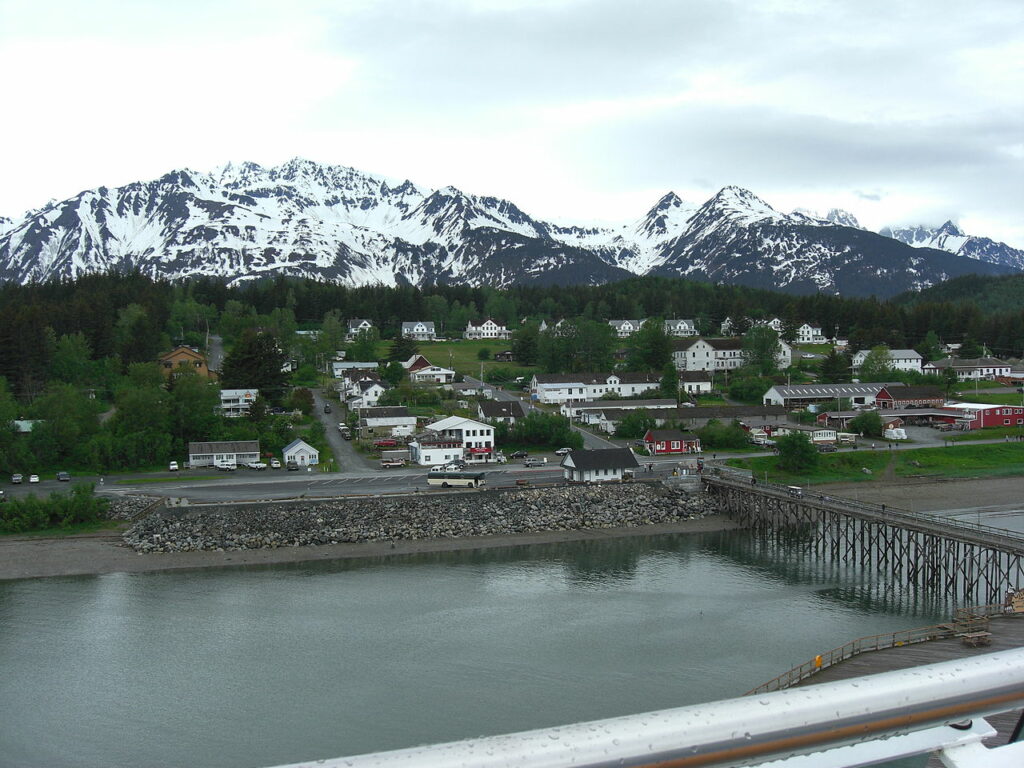
Fort William H. Seward, situated in southeast Alaska, is a unique historical landmark, being the only intact military base in Alaska that predates World War II.
This fort, named after U.S. Secretary of State William H. Seward, who famously negotiated the purchase of Alaska from Russia, played a significant role in Alaska’s early history, especially during the Klondike Gold Rush.
Below is an expanded overview of Fort William H. Seward’s history, including its establishment, major events, and its transformation into a historical site.
Fort William H. Seward was established to assert U.S. sovereignty in Alaska following its purchase from Russia in 1867.
The fort’s name honors Secretary of State William H. Seward, who was instrumental in negotiating the Alaska Purchase. The fort’s construction began in the early 20th century, intending to establish a permanent U.S. military presence in the region.
Role During the Klondike Gold Rush
The Klondike Gold Rush, which began in 1896, brought thousands of prospectors and adventurers to the Yukon region, passing through Alaska. Fort William H. Seward was critical in maintaining peace and order during this period.
The U.S. Army stationed at the fort was responsible for enforcing laws, preventing prospector conflicts, and assisting in emergencies.
Fort William H. Seward was known for its distinctive architecture and key structures.
The most notable buildings include the Chilkoot Barracks, which housed the soldiers, and the Commanding Officer’s House, which served as the residence for the highest-ranking officer at the fort.
These buildings were constructed using local materials and were designed to withstand the harsh Alaskan climate.
Military Operations and Activities
While primarily focused on peacekeeping during the Gold Rush, the fort also engaged in various military operations and training exercises.
These activities were crucial in maintaining the troops’ readiness and asserting the U.S. presence in the region.
Transition to a Historical Site
After its active military use, Fort William H. Seward transformed. Recognizing its historical significance, efforts were made to preserve the original buildings and the fort’s overall structure.
Today, it is part of Alaska’s historical port, Chilkoot, offering visitors a glimpse into early 20th-century military life in Alaska.
The fort’s original buildings have been meticulously preserved, including the barracks and the commanding officer’s house.
These structures now serve as a testament to the architectural style and military history of the early 1900s.
The site has become a popular destination for tourists and history enthusiasts, providing insights into the fort’s role in Alaska’s development.
3. Fort St. Michael (Old Fort Sitka)
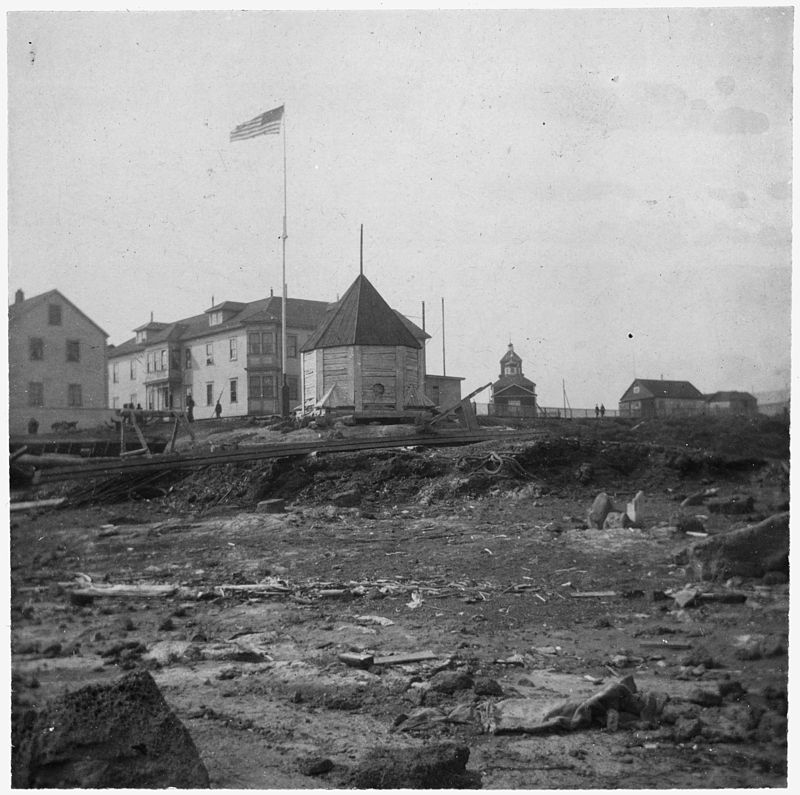
Old Sitka Fort, also known as Fort Saint Michael, is a historic site in Alaska with a rich and complex history. This fort, established by Russian traders in the early 19th century, played a significant role in the colonial era of Alaska.
Old Sitka Fort was established by Russian traders and explorers in 1804. Initially named Fort Saint Michael, this establishment was part of Russia’s efforts to expand its fur trading operations in the region.
The location was strategically chosen for its access to sea routes and its potential for lucrative fur trade, especially in sea otter pelts.
Conflict with the Tlingit People
Establishing the fort led to significant tensions with the local Tlingit people. These tensions culminated in the Battle of Sitka in 1804, a key event in the history of Old Sitka Fort.
The conflict arose from the Russian traders’ encroachment on Tlingit lands and their control over the lucrative fur trade. The pivotal battle marked a significant clash between indigenous Alaskans and European colonizers.
Old Sitka Fort was an important outpost for the Russian-American Company, the semi-governmental company that managed all Russian settlements in North America.
The fort served as a trading post and a base for the company’s operations in Alaska, playing a critical role in the region’s fur trade and colonial administration.
Destruction and Abandonment
After the Battle of Sitka, the original fort was destroyed. However, the Russians subsequently rebuilt it, continuing their operations in the area.
The fort’s importance declined over the years, especially after the transfer of Alaska to the United States in 1867. Eventually, the site was abandoned and fell into disrepair.
Preservation and Historical Significance
In the 20th century, recognizing the site’s historical significance led to efforts to preserve it. Today, Old Sitka Fort has been designated a National Historic Landmark.
The site offers visitors insights into the early Russian presence in Alaska and the interactions between Russian colonizers and indigenous peoples.
Although much of the original fort has been lost to time, archaeological excavations have unearthed various artifacts from the site.
These artifacts, including Russian and Tlingit items, provide a glimpse into the life at the fort and the cultural exchanges that occurred there.
Old Sitka Fort is commemorated as a symbol of the complex history of colonization, trade, and conflict in Alaska.
The site serves an educational purpose, helping visitors understand the historical dynamics between the Russian traders and the indigenous Tlingit people and the broader impact of colonialism in the region.
4. Fort Yukon
Fort Yukon was initially established by the Hudson’s Bay Company (HBC), a British fur trading company, in the 1840s. The fort was strategically located to exploit the Yukon River’s fur trade opportunities.
Its primary function during this time was as a trading post, where HBC traders exchanged goods with local indigenous communities for fur pelts, particularly beaver pelts, which were in high demand.
Fort Yukon’s role evolved after the Alaska Purchase in 1867 when the United States acquired Alaska from Russia. It became an important U.S. Army post.
This transition marked a significant change in the fort’s function, from a commercial trading post to a military installation.
The U.S. Army used the fort to establish and maintain an American presence in the newly acquired territory, which was especially important in the context of the U.S.’s expanding western frontier.
Role in Regional Development
As an army post, Fort Yukon played a crucial role in the region’s development. It served as a hub for exploration, mapping, and establishing American authority in the area.
The presence of the U.S. Army helped facilitate further exploration and development in the Alaskan interior, which was largely uncharted and unknown to American settlers and authorities at the time.
During the Klondike Gold Rush (late 1890s), Fort Yukon became a significant stopover and supply point for prospectors and miners heading to the gold fields.
Its strategic location along the Yukon River made it essential for transportation and commerce related to the gold rush activities.
5. Fort Liscum
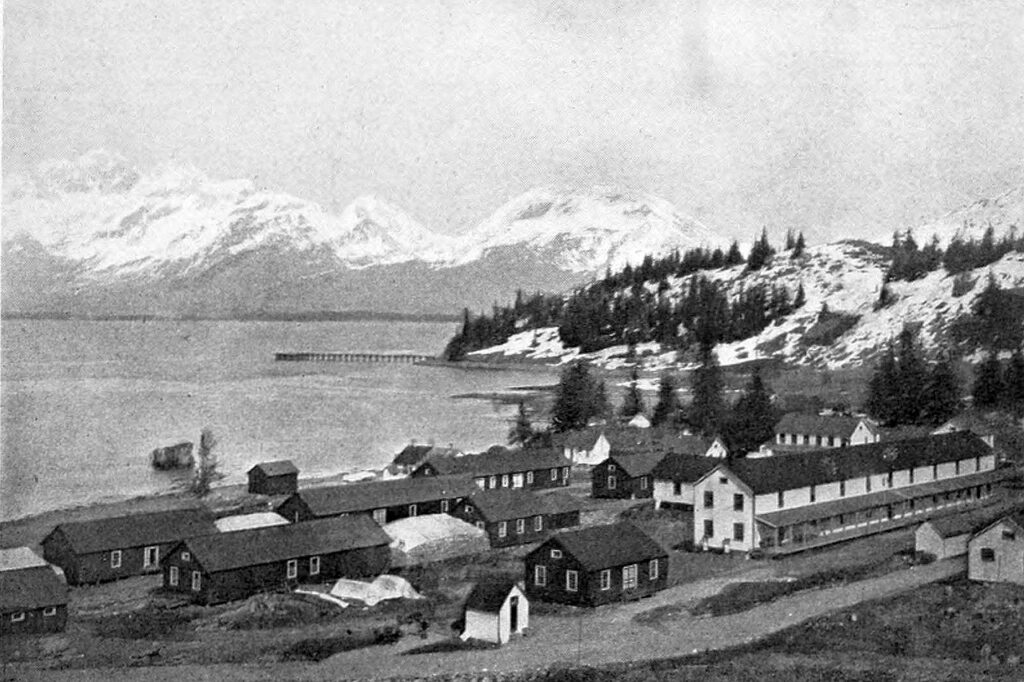
Fort Liscum was established in the early 20th century, a time when Alaska was experiencing significant changes and development due to the Gold Rush.
The fort’s location near Valdez was strategic, chosen for its accessibility and proximity to the interior regions of Alaska, which were becoming increasingly important due to the influx of prospectors and settlers.
Fort Liscum was crucial in supporting military and civilian operations during the Alaska Gold Rush.
Its proximity to the Alaska Highway made it a key logistical point for transporting goods, people, and equipment into the interior regions where gold mining activities were concentrated.
The fort provided a base for the U.S. Army to maintain order and support the burgeoning population and activities in the region.
Strategic Importance in Communication
One of the most significant roles of Fort Liscum was in the realm of communication.
It was a key point in the Washington-Alaska Military Cable and Telegraph System (WAMCATS), a major project the U.S. Army undertook to establish a telegraph system in Alaska.
This system was crucial for efficient communication across the vast territory, especially for military and governmental operations.
The fort’s location along this system underscored its strategic importance in the broader infrastructure of Alaska.
Fort Liscum housed U.S. Army troops and served as a center for various military operations during its active years.
The presence of the military at the fort was instrumental in ensuring the safety and security of the region, particularly during the chaotic times of the Gold Rush.
After serving its purpose during the Gold Rush and the early 20th century, Fort Liscum was eventually deactivated.
However, its historical significance remains. The fort is remembered for its strategic role in Alaska’s development, particularly in terms of transportation, communication, and military presence.
Preservation and Historical Significance
While much of Fort Liscum may not exist in its original form today, the site holds historical significance as a reminder of Alaska’s development during the early 20th century.
It symbolizes the military’s role in supporting the infrastructure and communication systems crucial for the region’s development.
Today, the site of Fort Liscum is a point of historical interest. It provides a glimpse into the military’s involvement in the development of Alaska during a pivotal period in the state’s history.
The fort’s role in the telegraph system and its contribution to the infrastructure during the Gold Rush era remain key aspects of its historical legacy.
6. Fort Davis
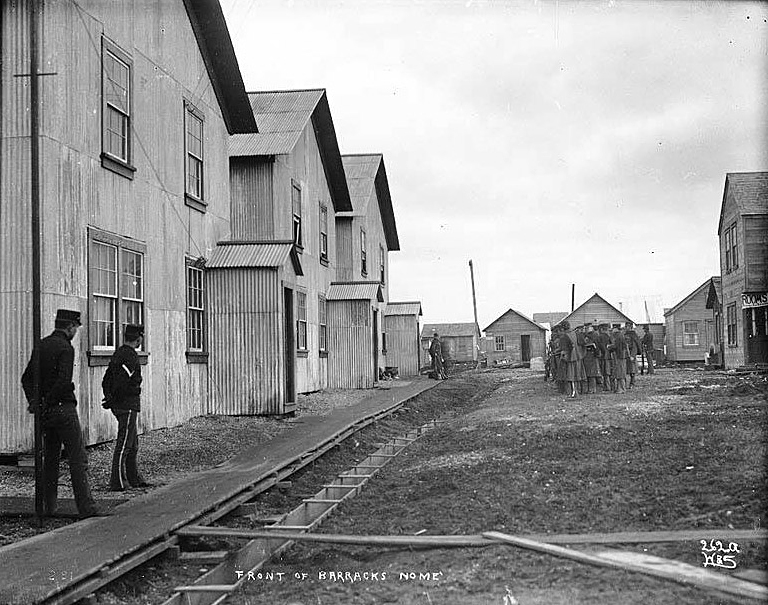
Fort Davis was established in response to the gold rush that gripped Nome and the surrounding areas in the late 19th century.
The influx of miners and the resulting economic boom created a need for a military presence to maintain order, provide support, and ensure the safety of the miners and local communities.
One of the primary functions of Fort Davis was to support the gold mining operations.
This support included maintaining law and order, providing logistical assistance, and offering protection against potential threats, both internal and external.
The fort’s presence was crucial in stabilizing the region, which was rapidly transforming due to the gold rush.
Military Significance and Defense
Fort Davis served as a vital outpost for the U.S. Army in Alaska. Its strategic location near Nome, one of Alaska’s key ports and mining centers, made it essential for defending American interests in the region.
The fort was part of the broader U.S. military strategy to establish and maintain a presence in Alaska, notably when the region underwent significant economic and demographic changes.
The strategic importance of Fort Davis extended to the defense of American soil against external threats.
During this period, the U.S. was vigilant about protecting its territories, especially in areas like Alaska, which were considered vulnerable due to their location and the wealth generated by resources like gold.
Deactivation and Legacy
Fort Davis was eventually decommissioned after serving its purpose during the gold rush and the subsequent years. However, its historical significance remains.
The fort is remembered for its role in supporting the gold rush in Nome, its contribution to the military presence in Alaska, and its part in the broader narrative of American expansion and defense.
Today, the site of Fort Davis stands as a testament to a pivotal era in Alaska’s history.
While much of the original structure may not exist, the location holds historical value.
Providing insights into the military’s role during the Nome gold rush and the challenges of maintaining security and order in a rapidly developing frontier region.
7. Fort Egbert
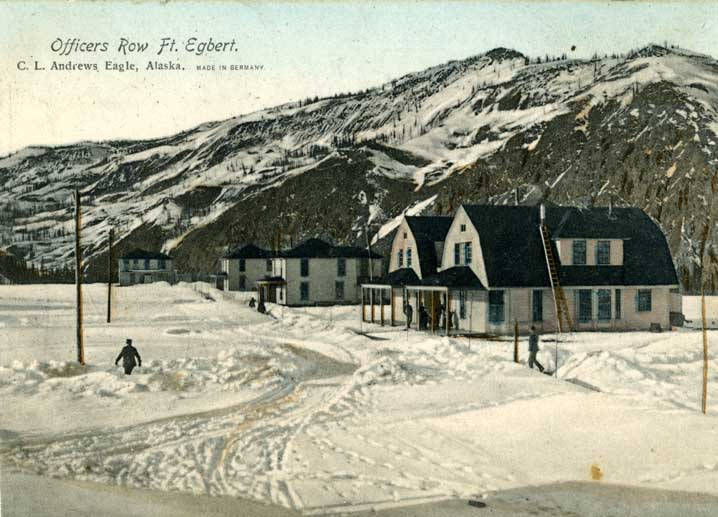
Fort Egbert was established in response to the gold rush that swept through Alaska at the turn of the 20th century.
The influx of prospectors and the economic boom created the need for a military presence to maintain order and support the burgeoning population in Eagle and the surrounding areas.
As a U.S. Army post, Fort Egbert played a critical role in supporting the gold mining operations and the communities that developed around them.
The fort provided logistical support, maintained law and order, and stabilized a region undergoing rapid and often chaotic change.
Involvement in Early Telegraph Communications
One of Fort Egbert’s most notable contributions was its role in early telegraph communications in Alaska.
Fort marked the beginning of the telegraph system in the region, a significant development in improving communication across the vast and sparsely populated territory.
This advancement was crucial for military operations, commercial activities, and the overall development of Alaska.
The U.S. Army Signal Corps, stationed at Fort Egbert, established and operated the telegraph system.
Their work laid the foundation for modern communication infrastructure in Alaska, demonstrating the technological ingenuity and resourcefulness of the military during this period.
The Fort as a Historical Site
Recognizing the historical significance of Fort Egbert, the Eagle Historical Society has undertaken efforts to preserve much of the original site.
This preservation allows visitors to return and experience life at the fort during the gold rush era.
Today, the site of Fort Egbert serves as a window into the past, offering insights into the daily operations of a military post during the gold rush and the early days of telecommunication in Alaska.
The preserved buildings and artifacts connect to the region’s history.
Fort Egbert’s preservation as a historical site has educational and cultural significance.
It helps understand the military’s role in Alaska’s economic and social development during the gold rush and the technological advancements in communication pioneered in the region.
The legacy of Fort Egbert extends beyond its military and communication roles. It symbolizes the broader narrative of American expansion, the gold rush era, and the early days of technological innovation in a frontier region.
The fort’s history is intertwined with the development of Alaska and the complexities of managing and advancing in such a challenging environment.
8. Fort Richardson
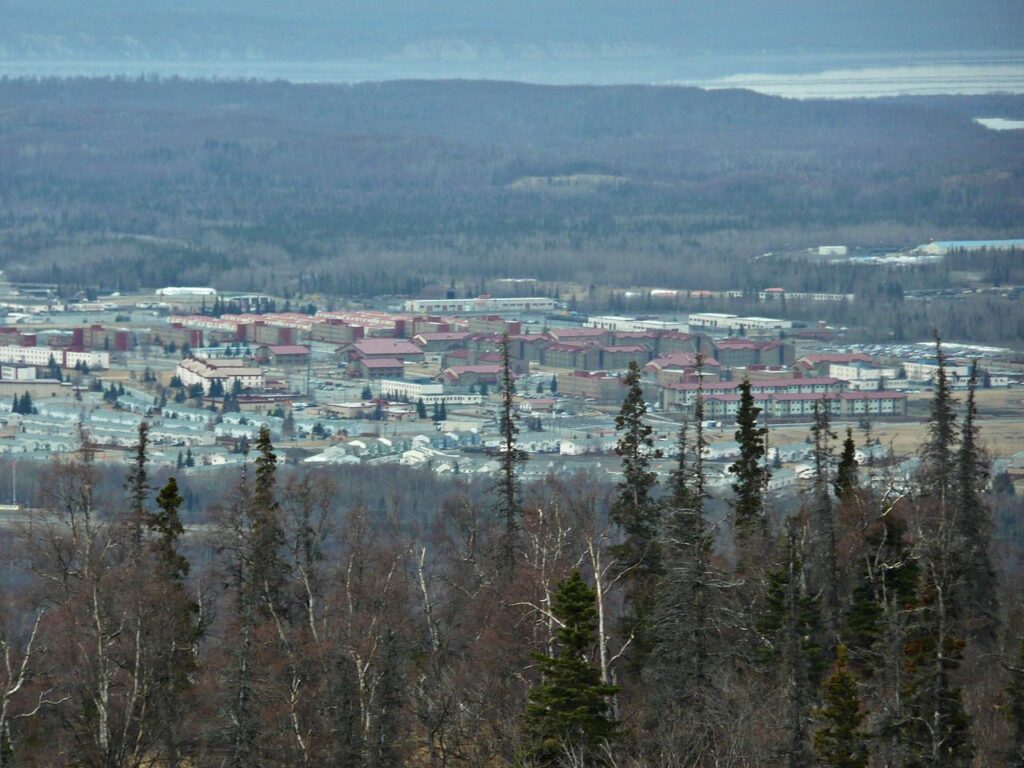
Fort Richardson was established during World War II, responding to the strategic needs of the United States military during this global conflict.
Its location near Anchorage was chosen for strategic reasons, primarily to bolster the defense of Alaska and the northern Pacific region.
After World War II, Fort Richardson continued to play an important role in U.S. military operations.
It underwent expansions and modifications to adapt to the changing needs and strategies of the U.S. military during the Cold War and beyond. This period saw the fort evolving from a purely defensive installation to a more versatile military base.
Diverse Military Functions
Fort Richardson serves multiple functions within the U.S. military framework in its modern form. It is a key location for various military units and operations, serving as a training ground, logistical hub, and support center for various military activities.
One of the significant changes in recent history has been the integration of Fort Richardson with Elmendorf Air Force Base.
This integration created Joint Base Elmendorf-Richardson (JBER), which combined the resources and capabilities of both installations.
This consolidation has enhanced operational efficiency and effectiveness, making JBER a significant military site in the United States’ defense infrastructure.
Training and Readiness Operations
As part of JBER, Fort Richardson is actively involved in training and readiness operations.
It provides facilities and resources for training military personnel in various capacities, ensuring they are prepared for diverse missions and challenges.
The strategic importance of Fort Richardson in contemporary defense is underscored by its location and the range of capabilities it offers.
Its proximity to the Arctic region and the Pacific Rim makes it vital to U.S. military strategy in these geopolitically significant areas.
9. Fort McGilvray
Fort McGilvray, situated on Caines Head near Seward, Alaska, was a significant military construction developed during World War II.
Its primary purpose was to protect the Alaskan coastline, a task of increasing importance given the global context of the war and the strategic significance of the Northern Pacific region.
As a key component of the coastal defense system, Fort McGilvray included essential military features such as gun batteries and searchlight shelters. Here’s a detailed overview of Fort McGilvray’s history and role during the war:
Fort McGilvray was constructed as part of the United States’ effort to strengthen its coastal defenses during World War II.
This period saw heightened concerns about potential invasions, particularly along the Pacific coast, prompting the establishment of several military installations, including Fort McGilvray.
Strategic Location for Coastal Defense
The location of Fort McGilvray on Caines Head was strategically chosen. Its position near Seward allowed for effective monitoring and defense of the Alaskan coastline, which was crucial during World War II.
The fort’s placement was intended to provide a strong line of defense against any naval or aerial incursions, particularly by Axis powers in the Northern Pacific.
Fort McGilvray was equipped with gun batteries designed to defend against enemy ships. These batteries were complemented by searchlight shelters, which were critical for night-time operations and surveillance.
The combination of these features made the fort a formidable defensive position.
Throughout World War II, Fort McGilvray served as a vital part of the United States’ coastal defense network.
It helped secure the Northern Pacific region, ensure the safety of maritime routes, and provide a strategic advantage to U.S. military operations in the area.
Post-World War II and Legacy
Following the end of World War II, the strategic importance of Fort McGilvray diminished, and it was eventually decommissioned. However, its legacy as a key defensive installation during a critical period in world history remains.
The fort’s history is reflective of the broader efforts to secure the United States’ borders during a time of global conflict.
Today, Fort McGilvray stands as a historical site, offering a glimpse into the military history and defensive strategies of the mid-20th century.
The fort’s preservation allows visitors to explore its structures and understand the complexities of coastal defense during World War II.
10. Fort Greely

Fort Greely was originally established during World War II, and this period marked a significant expansion of military installations across the United States, particularly in strategic locations like Alaska.
The fort’s initial purpose was to serve as a defense post, playing a part in the broader efforts to secure the nation during the global conflict.
Following World War II, Fort Greely adapted to the changing needs of the U.S. military.
During the Cold War, its strategic importance continued, albeit with evolving roles in line with the new geopolitical realities. The fort underwent several modifications and expansions to meet the demands of the time.
Test and Training Center
One of the key components of modern Fort Greely is the Cold Regions Test Center. This facility is dedicated to testing military equipment and technologies in extreme cold weather conditions.
The center ensures that the U.S. military’s equipment can operate effectively in some of the harshest climates on Earth, a necessity given the global scope of U.S. military operations.
Fort Greely also houses the Northern Warfare Training Center alongside the Test Center. This center provides rigorous training to military personnel for cold, mountainous, and arctic operations.
The training encompasses a range of skills necessary for survival and effectiveness in such challenging conditions.
Evolving Role in National Defense
Over the years, Fort Greely’s role in national defense has evolved significantly. From a World War II defense post, it has become a crucial hub for testing and training in extreme conditions.
This evolution reflects the changing dynamics and needs of military preparedness in the modern era.
Fort Greely’s current functions underscore its importance in military innovation and readiness.
The facilities at the fort contribute to the development of cutting-edge military technologies and the preparation of troops for diverse environmental challenges.
Related: Army Forts in Alaska
Conclusion – Historic Forts in Alaska
Each of these historic forts in Alaska offers a window into the past, showcasing the diverse roles played by military installations in the history of the United States.
From serving as outposts during the gold rush to playing key roles in defending American soil during World War II, these forts are integral to understanding Alaska’s and America’s military heritage.

Cory is a website owner and content creator who enjoys fishing, history, coin collecting, and sports, among other hobbies. He is a husband and father of four.
Romans 15:4 For whatever was written in former days was written for our instruction, that through endurance and through the encouragement of the Scriptures we might have hope.

